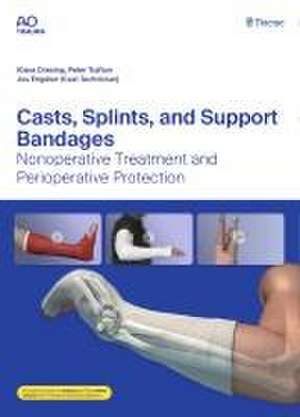Casts, Splints, and Support Bandages – Nonoperative Treatment and Perioperative Protection
Autor Klaus Dresing, Peter G Traftonen Limba Engleză Hardback – 16 dec 2014
Preț: 1049.98 lei
Preț vechi: 1363.60 lei
-23% Nou
Puncte Express: 1575
Preț estimativ în valută:
200.92€ • 210.74$ • 167.26£
200.92€ • 210.74$ • 167.26£
Carte disponibilă
Livrare economică 07-13 martie
Livrare express 25 februarie-01 martie pentru 99.01 lei
Preluare comenzi: 021 569.72.76
Specificații
ISBN-13: 9783132444720
ISBN-10: 3132444723
Pagini: 652
Ilustrații: 2497 Abbildungen
Dimensiuni: 210 x 280 x 15 mm
Greutate: 1.95 kg
Editura: MM – Thieme
ISBN-10: 3132444723
Pagini: 652
Ilustrații: 2497 Abbildungen
Dimensiuni: 210 x 280 x 15 mm
Greutate: 1.95 kg
Editura: MM – Thieme
Cuprins
Section 1: Principles of casting
1 Introduction
2 History of casting-from the beginning to the present
3 Principles of casting
4 Thrombosis prophylaxis
5 Logistics and resources in the cast room
6 Properties of cast materials
7 Socioeconomic considerations
8 Outcomes after nonoperative fracture treatment-what information can be gained from evidence-based medicine?
Section 2: Guidelines for nonoperative treatment and perioperative protection
9.1 Fractures, dislocations, and subluxations of the upper extremity
9.2 Fractures, dislocations, and subluxations of the lower extremity
9.3 Nonoperative treatment of spinal fractures
9.4 Pediatric fractures
10 Soft-tissue damage and defects
11.1 Ligament and tendon injuries
11.2 Nerve injuries
12 Indications for nonoperative treatment of infections
13 Overload Injuries
Section 3: Techniques-casts, splints, and support bandages
14.1 Overview of cast, splint, orthosis, and bandage techniques
14.2 Overview of cast, splint, orthosis, and bandage techniques-demonstration format and icons
15 Upper extremity
16 Lower extremity
17 Spine
18 Support bandages
1 Introduction
2 History of casting-from the beginning to the present
3 Principles of casting
4 Thrombosis prophylaxis
5 Logistics and resources in the cast room
6 Properties of cast materials
7 Socioeconomic considerations
8 Outcomes after nonoperative fracture treatment-what information can be gained from evidence-based medicine?
Section 2: Guidelines for nonoperative treatment and perioperative protection
9.1 Fractures, dislocations, and subluxations of the upper extremity
9.2 Fractures, dislocations, and subluxations of the lower extremity
9.3 Nonoperative treatment of spinal fractures
9.4 Pediatric fractures
10 Soft-tissue damage and defects
11.1 Ligament and tendon injuries
11.2 Nerve injuries
12 Indications for nonoperative treatment of infections
13 Overload Injuries
Section 3: Techniques-casts, splints, and support bandages
14.1 Overview of cast, splint, orthosis, and bandage techniques
14.2 Overview of cast, splint, orthosis, and bandage techniques-demonstration format and icons
15 Upper extremity
16 Lower extremity
17 Spine
18 Support bandages
